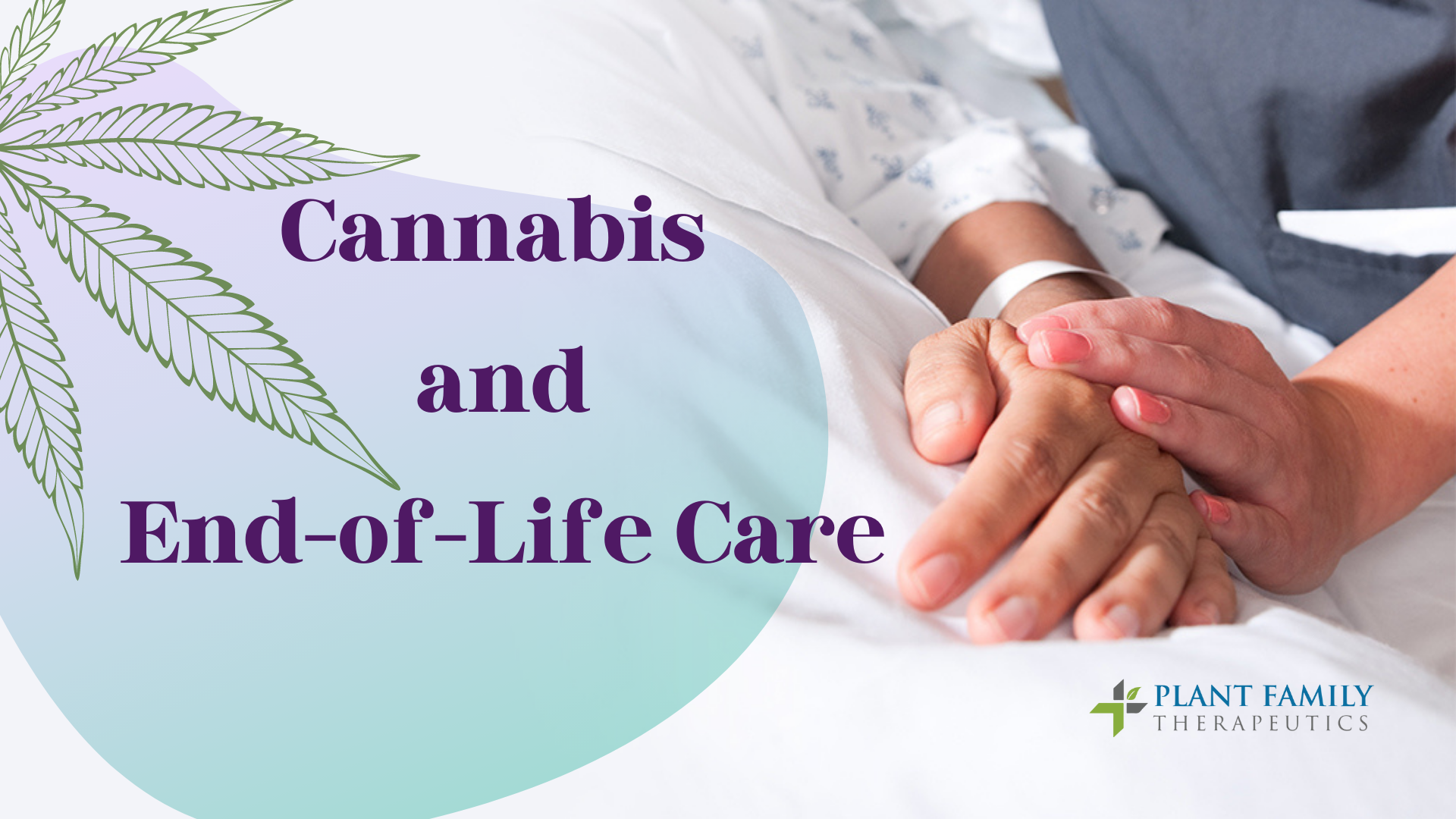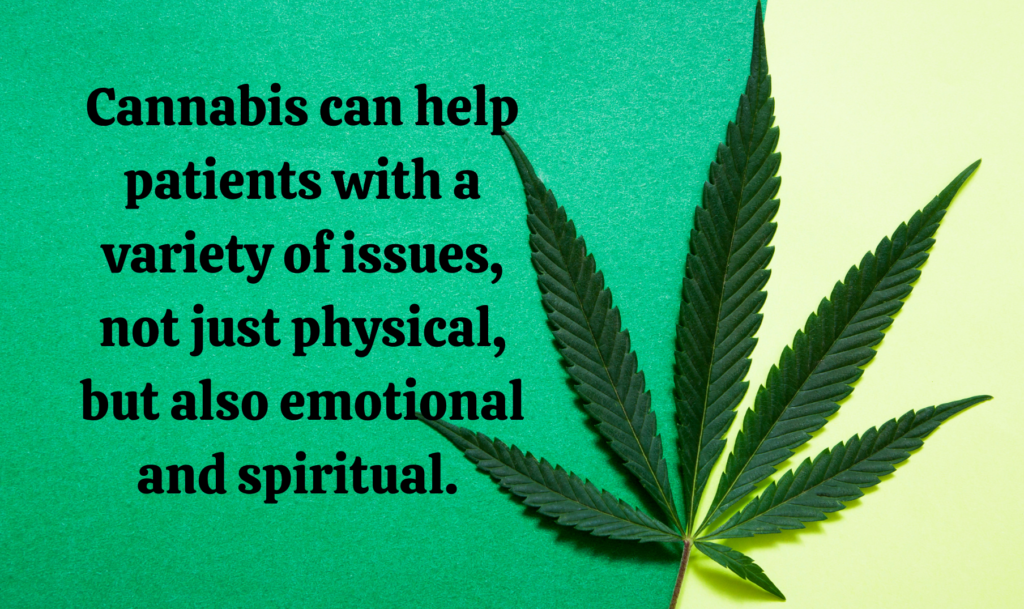This website requires you to be 21 years or older to enter. Please confirm your age below to continue.

Cannabis has been used medicinally around the world for thousands of years to manage a wide variety of conditions, and through research, many of those conditions including pain, nausea, insomnia, and mood enhancement have been proven. The rapidly growing use of medicinal cannabis in the United States is leading to an increase in the number of patients asking about its use, particularly for those with terminal illnesses.
Facing end-of-life is one of the most challenging things a person will go through. It is a painful and emotional time for the patient, family members, and caregivers. End-of-life care focuses on making patients more comfortable and offers support during their final stage of life, addressing the whole person, rather than just the disease, focusing on things like pain, physical distress and emotional and spiritual issues.
Historically, end-of-life care utilizes a combination of opioids, benzodiazepines, and antipsychotic medications to help ease patients’ suffering. While often necessary, these medications come with many agonizing side effects, particularly with the higher doses typically needed to achieve relief of symptoms, leaving the patient more lethargic and more confused, with nausea, vomiting and depression. Cannabis has been shown to reduce harm and unwanted side effects when used alone or in combination with medications.
Palliative patients frequently experience a wide range of symptoms from physical discomfort and psychological disorders as well as existential and spiritual concerns. Cannabis is one of the few compounds that can help with pain, nausea, insomnia, anxiety, depression, shortness of breath, agitation and even fatigue, which are all common complaints in palliative care.
Because cannabis is still classified as a Schedule I substance, labeling cannabis as having no therapeutic benefit, hospices find it difficult to advocate for its usage without risking losing government reimbursement and support. Conflicting rules, ongoing stigma, research restrictions, and product scarcity—all resulting from a lack of awareness and education among patients and physicians—have hampered the advantages of introducing cannabis into palliative care.
However, in some states (and countries), palliative and end-of-life care are considered qualifying conditions for the prescription of medical cannabis. Family members and caregivers reported that cannabis played a beneficial and therapeutic role by reducing the need for narcotics (patients were more alert and responsive with cannabis over narcotics), nausea, anxiety and depression were also reduced, and cannabis brought a sense of calm or spiritual peace to the patient.
What do the professionals think?
A total of 310 palliative professionals including nurses, administrators and physicians from 40 different states responded to the nation’s largest survey on practice, experience and opinions regarding medical cannabis and palliative care. Regardless of legality, an overwhelming 91% indicated they would support the use of medical cannabis for hospice and palliative care.
Unfortunately, there are several barriers to the use of cannabis currently – half of the physician respondents indicated they do not write orders to certify patients for medical cannabis (normally it’s your primary physician), state legal status and concerns about efficacy and safety (due to lack of education), and hospice/insurance may not cover the cost of cannabis.
There is a lack of clinical research regarding the effectiveness of cannabis in treating symptoms when approaching death. In 2018 a systematic review of cannabis in palliative care was performed using 10 clinical trials. Only one of the trials use cannabis herb. The focus on pharmaceutical cannabis and

excluding the natural cannabis herb is problematic as the natural cannabinoids, terpenes and other flavonoids that allow the entourage effect (which may be more effective at reducing symptoms) are lacking from the synthetic versions.
A son’s story
“I have a story to tell from a caregiver’s point of view about cannabis and end-of-life care. I was unfamiliar with end-of-life medications and what to expect. The hospice nurse told me to expect a lot of sleeping, confusion, constipation, and that they may not be able to control my father’s pain completely due to the advanced state he was in.
A friend of mine stated she gave cannabis to her father and described his passing as a peaceful experience without suffering. My father had pancreatic cancer that metastasized, and I was not sure how or if it would give him any relief. My father and I thought he should try cannabis.
I was surprised at the response he had. My dad was more like his old self than I’d seen for months and did not complain of pain or discomfort. He would often giggle and have a smile on his face as we reminisced about the past and the adventures of his life.
The memories we have are so very precious, and the last month we shared are now some of my favorite memories with him. The final days before my father passed were some of the best days he’d had in a very long time. I knew as he drifted off to sleep for the last time he was comfortable and pain-free.
I am truly thankful for cannabis and believe without a shadow of a doubt that we made the right choice.”
Conclusion
There is a need to know more about cannabis use among the terminally ill, specifically whether it operates as a complement or alternative to palliative care. As with all medical treatment, the use of cannabis depends on the individual patient, their history and their sensitivity to THC.
End-of-life care focuses on providing patients relief from pain and other symptoms of a serious illness, no matter the diagnosis or stage of the disease. Medical cannabis has become widely accepted across the United States as a safe alternative to opioids for pain relief, so why is it not approved for end-of-life care?
Despite the lack of clinical studies, patients, physicians and caregivers support the use of cannabis in end-of-life care. There is a need for further clinical research using cannabis herb rather than pharmaceutical synthetic cannabis.
Cannabis can be used in a number of ways in end-of-life care, both as an adjunct and a supplement to traditional care. It can help patients with a variety of issues, not just physical but also emotional and spiritual.
References
Aggarwal S. K. (2016). Use of cannabinoids in cancer care: palliative care. Current oncology (Toronto, Ont.), 23(2), S33–S36. https://www.ncbi.nlm.nih.gov/pmc/articles/PMC4791145/#!po=75.0000
Anand, U., Pacchetti, B., Anand, P., & Sodergren, M. H. (2021). Cannabis-based medicines and pain: a review of potential synergistic and entourage effects. Pain management, 11(4), 395–403. https://doi.org/10.2217/pmt-2020-0110
Braun, I. M., Wright, A., Peteet, J., Meyer, F. L., Yuppa, D. P., Bolcic-Jankovic, et. al. (2018). Medical Oncologists’ Beliefs, Practices, and Knowledge Regarding Marijuana Used Therapeutically: A Nationally Representative Survey Study. Journal of clinical oncology: official journal of the American Society of Clinical Oncology, 36(19), 1957–1962. https://doi.org/10.1200/JCO.2017.76.1221
Connor, S. R., & Gwyther, E. (2018). The Worldwide Hospice Palliative Care Alliance. Journal of pain and symptom management, 55(2S), S112–S116. https://doi.org/10.1016/j.jpainsymman.2017.03.020
Costantino, R. C., Felten, N., Todd, M., Maxwell, T., & McPherson, M. L. (2019). A Survey of Hospice Professionals Regarding Medical Cannabis Practices. Journal of palliative medicine, 22(10), 1208–1212. https://doi.org/10.1089/jpm.2018.0535
Croker, J., Bobitt, J., Arora, K., Kaskie, B. (2022). Medical cannabis and utilization of nonhospice palliative care services: Complements and alternatives at end of life. Innovation in Aging, 6(1), 2022, igab048, https://doi.org/10.1093/geroni/igab048
Graczyk, M., and Leppert, W. (2021) The role of cannabinoids in the management of symptoms in palliative care patients. Palliat Med Pract., 15(2),182-191 https://doi.org/10.5603/PMPI.2021.0016
Häuser, W., Fitzcharles, M. A., Radbruch, L., & Petzke, F. (2017). Cannabinoids in Pain Management and Palliative Medicine. Deutsches Arzteblatt international, 114(38), 627–634. https://doi.org/10.3238/arztebl.2017.0627
Luba, R., Earleywine, M., Farmer, S., & Slavin, M. (2018). Cannabis in End-of-Life Care: Examining Attitudes and Practices of Palliative Care Providers. Journal of psychoactive drugs, 50(4), 348–354. https://doi.org/10.1080/02791072.2018.1462543
Mücke, M., Weier, M., Carter, C., Copeland, J., Degenhardt, L., Cuhls, H., Radbruch, L., Häuser, W., & Conrad, R. (2018). Systematic review and meta-analysis of cannabinoids in palliative medicine. Journal of cachexia, sarcopenia and muscle, 9(2), 220–234. https://doi.org/10.1002/jcsm.12273
Van Lancker, A., Velghe, A., Van Hecke, A., Verbrugghe, M., Van Den Noortgate, N., Grypdonck, M., Verhaeghe, S., Bekkering, G., & Beeckman, D. (2014). Prevalence of symptoms in older cancer patients receiving palliative care: a systematic review and meta-analysis. Journal of pain and symptom management, 47(1), 90–104. https://doi.org/10.1016/j.jpainsymman.2013.02.016